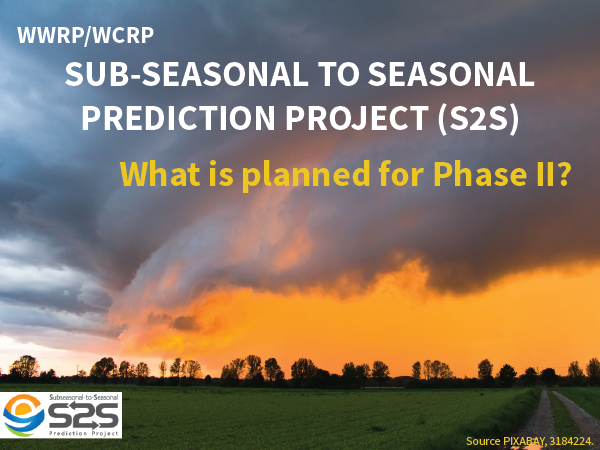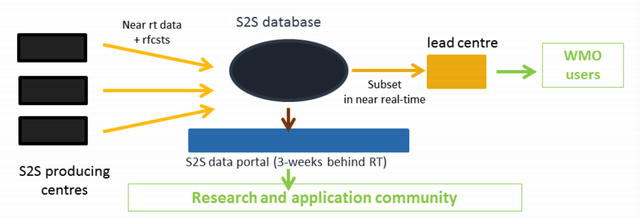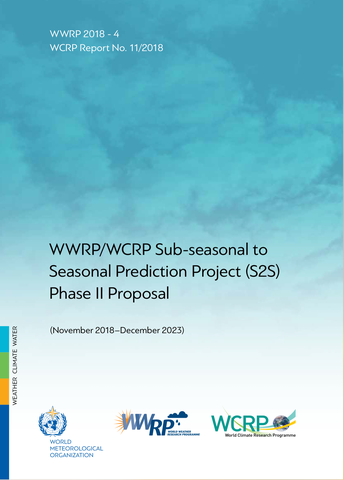
Background: The first phase of S2S
The Sub-seasonal to Seasonal Prediction Project (S2S) was launched as a joint project of the World Climate Research Programme (WCRP) and the World Weather Research Programme (WWRP) in November 2013. It has the primary goals of improving forecast skill and understanding the dynamics and climate drivers, to 'fill the gap' between weather forecasts and seasonal climate predictions, from two weeks to a season ahead (Figure 1). Special emphasis was put on high-impact weather events, developing coordination among operational centers via WMO’s Commission for Basic Systems (CBS), and on promoting uptake of S2S information by the applications communities, in the context of the Global Framework for Climate Service (GFCS). In WWRP, S2S is, together with the Polar Prediction Project (PPP) and the High Impact Weather project (HIWeather), one of the three activities that succeeded The Observing System Research and Predictability Experiment (THORPEX).

The S2S Database (Figure 2), launched in 2015, has enabled major research activity on S2S predictability, modeling, forecast verification, and product development, with over 40 articles published to date that use S2S database, and over 1000 users from over 90 countries. It contains sub-seasonal forecasts (3 weeks behind real time) and re-forecasts and is hosted by the European Centre for Medium-Range Weather Forecasts (ECMWF) and the China Meteorological Administration (CMA). A large subset of data is also included in the International Research Institute's (IRI's) Climate Data Library at Columbia University, USA (see separate article, in this issue). In its first five years, S2S has organized or co-organized over 18 science workshops or sessions and nine training courses. These events were aimed at building capacity, with many targeted at meteorological services and researchers from developing countries. Six S2S sub-projects were established to coordinate research and to foster the development of a global S2S climate and weather research community, and a series of case studies were carried out as part of the sub-project on extremes.

As a result of S2S' activities, the WMO Lead Centre for Long Range Forecasting and Multimodel Ensembles (LC-LRFMME) began a pilot real-time sub-seasonal Multimodel Ensemble (MME) prediction system in 2015, taking advantage of the S2S database at ECMWF, but without the 3-week delay placed on public access. Another payoff of the project is that all 11 operational centers in S2S now issue their forecasts every Thursdays (including the four models with daily forecast starts), compared with only 7 in 2013, greatly facilitating making multi-model forecasts.
Gap Analysis
While S2S can point to some major successes, much of the research, product development, and uptake by the applications communities are still in early stages, and a lot still needs to be done to realize the vision of skillful S2S forecasts of societal value. But what should a potential 5-year “Phase II” of S2S focus on? To inform future plans, a questionnaire was circulated to the research, modeling and operational communities for feedback. Frequently mentioned gaps included:
- Land-surface processes and initialization;
- Ensemble generation, including initialization, perturbation methods, and stochastic physics;
- Coupled data assimilation and the role of the ocean and sea ice on the sub-seasonal forecasts;
- Stratospheric processes; and
- Understanding model systematic errors and error growth.
Some of the database and operational gaps raised included a:
- Need for more convenient and faster access to popular suites of variables, including ensemble means, model climatologies, indices, and map displays;
- Need for multi-model calibrated forecast product development;
- Desire for more extensive re-forecast sets (number of years and ensemble members) for verification and forecast calibration, and to encourage centres to harmonize re-forecasts;
- Request for more ocean data including 3D fields, increased model horizontal and temporal resolution; and
- Desire for real-time access.
In addition, eight semi-structured interviews were conducted with stakeholders from the larger community related to applications, services, donors, or other stakeholders. The interviews were conducted under the leadership of WWRP’s Working Group on Societal and Economic Research Applications (SERA), an expert group founded under THORPEX. The interviewees generally agreed that while the potential benefits of skillful S2S forecasts are high, several barriers hinder their realization, namely:
- Lack of accuracy/poor skill - high level of accuracy is required for many types of decision-making;
- Lack of post-processing - need for statistical post-processing techniques to calibrate forecast for reliable probabilities;
- Lack of forecast verification: request that forecasts always be provided with verification information;
- Lack of stability in forecast model output: instability/persistence of the rainfall in the forecasts prevented the use of the forecast, or they became reliable only close to the actual event;
- Challenges in the interpretation of probabilities - a large share of users struggle to interpret probabilities and can have low expertise in risk management.
Plans for Phase II
To maximize progress in filling these upstream and downstream gaps, a set of core activities was proposed for the second phase of S2S, scheduled to begin at the end of 2018: S2S database enhancement, research activities (new sub-projects), and enhancing operational infrastructure and user applications (Figure 3). Work will continue to maintain and enhance the current S2S database at ECMWF, CMA, and IRI, within the constraints of the in-kind support to S2S provided by these centers. Ocean variables will be added to the S2S database, as per the original plan, and more surface variables four times a day (instead of only once a day), such as 10m wind needed for energy applications, will be considered. Additional models may be added, such as the extended-range forecasts from the Indian Meteorological Department.
A new set of research sub-projects are in the planning stages, to build and strengthen collaborations between WCRP, WWRP and WMO projects and working groups as well as to address the needs highlighted in the gap analysis:
- MJO prediction and teleconnections in collaboration with the WCRP Joint Scientific Committee (JSC) and the WMO Commission for Atmospheric Sciences (CAS) Working Group on Numerical Experimentation (WGNE) Madden-Julian Oscillation (MJO) Task Force (MJO-TF) with a focus on MJO/high-impact weather relationships and tropical-extratropical interactions;
- Land initialization and configuration, in coordination with the Global Energy and Water Exchange/Global Land Atmosphere System Study (GEWEX/GLASS), Data Assimilation and Observing Systems (DAOS), EartH2Observe and the Working Group on Subseasonal to Interdecadal Prediction (WGSIP) SNOWGLACE, to investigate the fidelity of model representations of land-atmosphere interactions, and how S2S forecasts may be improved by taking better advantage of the information contained in land surface states;
- Ocean and sea ice initialization and configuration in coordination with WGSIP, DAOS, and Predictability, Dynamics, Ensemble Forecasting (PDEF) Working Groups to promote improved sub-seasonal predictions though improved initialization of the ocean-sea ice state and depiction of key ocean and sea ice processes that provide predictability at sub-seasonal timescales;
- The Stratosphere, in collaboration with the WCRP / Stratosphere-troposphere Processes And their Role in Climate (SPARC) initiative on Stratospheric Network for the Assessment of Predictability (SNAP), with focus on quantification and understanding of stratosphere/troposphere coupling, model biases, initial conditions and ensemble generation, and whole atmosphere diagnostics;
- Atmospheric Composition, in collaboration with WGNE and the Global Atmospheric Watch (GAW) to assess the benefits of using prognostic aerosols rather than the climatology used in the current operational S2S models, identify the level of aerosol model complexity needed, and assess the predictability of aerosols (e.g. dust) at the S2S time-scale, and potential forecast value for applications;
- Ensemble generation, in collaboration with PDEF and WGNE, to determine (on the S2S scale) the optimal initial-perturbation strategies, the sources of over-confident forecasts, and the importance of initial perturbations of the ocean and stochastic parameterization schemes.
- Enhancement of operational infrastructure and user applications (third focus area of S2S Phase II). The operational global producing centers have been the backbone of S2S, and the transition of S2S research to operations (“R2O”) will be fundamental to S2S Phase II by developing/testing methodologies for calibration, multi-model combination, verification and generation of forecast products; and, in coordination with the relevant WMO technical commissions to define the standards and protocols for operational implementation and exchange of S2S forecasts. The goal is to transition the data-exchange infrastructure that supports research into the operational domain by the end of Phase II.
To promote user-uptake of S2S forecasts (which are delayed 3 weeks behind real time in the S2S database), a Real-time Pilot for S2S Applications research and demonstrations “S2S-SERA” is planned to make the S2S data available as close as possible to real-time during a limited period of time (1–2 years) for a limited number of users. GFCS has a focus on developing countries, particularly Africa, where several new projects have specific elements on sub-seasonal prediction, including W2-SIP (WISER), ForPAc (SHEAR) and SWIFT (GCRF). These projects offer exciting opportunities to coordinate on training, product development, and evaluation, as part of a real-time demonstration to trial products.
Please see the S2S website s2sprediction.net (maintained by the S2S International Coordination Office (ICO), hosted by the Korean Meteorological Agency) for more details and to get involved, to access the S2S database, read the S2S Newsletter (sign up on the homepage - published quarterly by the ICO), and where the Phase I Report, and Phase II Proposal and more can be found.
Article author: Andrew W. Robertson (International Research Institute for Climate and Society (IRI), Columbia University, Palisades, NY, USA)


